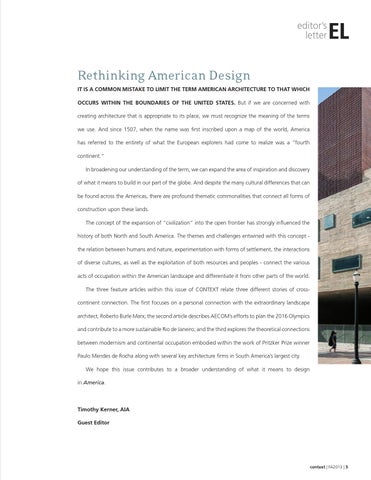editor’s letter
EL
Rethinking American Design It is a common mistake to limit the term American Architecture to that which occurs within the boundaries of the United States. But if we are concerned with creating architecture that is appropriate to its place, we must recognize the meaning of the terms we use. And since 1507, when the name was first inscribed upon a map of the world, America has referred to the entirety of what the European explorers had come to realize was a “fourth continent.” In broadening our understanding of the term, we can expand the area of inspiration and discovery of what it means to build in our part of the globe. And despite the many cultural differences that can be found across the Americas, there are profound thematic commonalities that connect all forms of construction upon these lands. The concept of the expansion of “civilization” into the open frontier has strongly influenced the history of both North and South America. The themes and challenges entwined with this concept the relation between humans and nature, experimentation with forms of settlement, the interactions of diverse cultures, as well as the exploitation of both resources and peoples - connect the various acts of occupation within the American landscape and differentiate it from other parts of the world. The three feature articles within this issue of CONTEXT relate three different stories of crosscontinent connection. The first focuses on a personal connection with the extraordinary landscape architect, Roberto Burle Marx; the second article describes AECOM’s efforts to plan the 2016 Olympics and contribute to a more sustainable Rio de Janeiro; and the third explores the theoretical connections between modernism and continental occupation embodied within the work of Pritzker Prize winner Paulo Mendes de Rocha along with several key architecture firms in South America’s largest city. We hope this issue contributes to a broader understanding of what it means to design in America.
Timothy Kerner, AIA Guest Editor
context | FA2013 | 5
